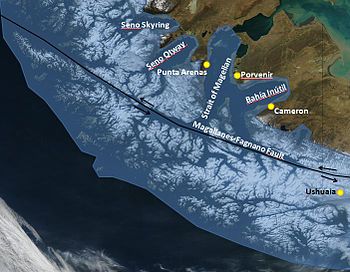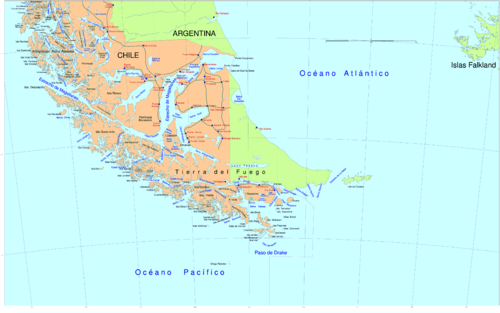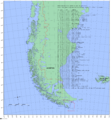- Strait of Magellan
-
The Strait of Magellan (also called the Straits of Magellan or the Magellanic Strait) comprises a navigable sea route immediately south of mainland South America and north of Tierra del Fuego. The waterway is the most important natural passage between the Pacific and the Atlantic oceans, but it is considered a difficult route to navigate because of the unpredictable winds and currents and the narrowness of the passage.
Contents
History
Ferdinand Magellan (Portuguese: Fernão de Magalhães), a Portuguese sailor in the service of Charles I of Spain, became the first European to navigate the strait in 1520 during his global circumnavigation voyage.
On March 22, 1518, the expedition was organized in Valladolid, naming Magellan captain general of the fleet and governor of all the lands discovered, and establishing the privileges of Magellan and his business associate Ruy Falero. The fleet would become known as the "Armada de las Molucas" or "Navy of the Moluccas". The expeditionary fleet of 5 ships set sail from Sanlucar de Barrameda on September 20, 1519.
The five ships included La Trinidad (100 to 110 barrels) under the command of Magellan; La San Antonio (120 barrels) under the command of Juan de Cartagena; La Concepción (90 barrels) under the command of Gaspar de Quezada (Juan Sebastián Elcano served as boatswain); La Victoria (85 barrels) under the command of Luis de Mendoza; and La Santiago, under command of Juan Rodríguez Serrano.
Magellan's ships entered the strait on November 1, 1520, All Saints' Day, and the strait was therefore originally named Estrecho de Todos los Santos (Strait of All Saints). Later[when?] the Spanish king[who?] changed the name to Estrecho de Magallanes in honor of Magellan. The Spanish Empire and the Captaincy General of Chile used it as the southern boundary of their territory. The first Spanish colonization attempt was led in 1584 by Pedro Sarmiento de Gamboa, who founded Nombre de Jesús and Rey Don Felipe on the northern shore of the strait. These towns suffered severe food shortages, and when the English navigator Sir Thomas Cavendish landed at the site of Rey Don Felipe in 1587, he found only ruins of the settlement. He renamed the place Port Famine. Other early explorers included Francis Drake. The strait was first carefully explored and thoroughly charted by Phillip Parker King, who commanded the British survey vessel HMS Adventure, and in consort with HMS Beagle spent five years surveying the complex coasts around the strait. This survey was presented at a meeting of the Royal Geographical Society in 1831.[citation needed]
Incorporation into Chile
Chile took possession of the channel on May 23, 1843. Chilean president Bulnes ordered this expedition after consulting the Chilean libertador Bernardo O'Higgins (1778-1842), who feared an occupation by Great Britain or France. The first Chilean settlement was Fuerte Bulnes, situated in a forested zone on the north side of the strait. Fuerte Bulnes was later abandoned, and in 1848 the city of Punta Arenas was founded farther north where the Magellanic forests meets the Patagonian plains. In Tierra del Fuego, across the strait from Punta Arenas, the village of Porvenir emerged during a gold rush in the late 19th century.
Argentina effectively recognized Chilean sovereignty over the Strait of Magellan in the Boundary treaty of 1881 between Chile and Argentina. Argentina had previously claimed all of the strait, or at least the eastern third of it.
Until the Panama Canal opened in 1914, the Strait of Magellan was the main route for steam ships traveling from the Atlantic Ocean to the Pacific. It was often considered the only safe way to move between the Atlantic and Pacific Oceans, as the Drake Passage separating Cape Horn (the southern tip of South America) from Antarctica is notorious for turbulent and unpredictable weather, and is frequented by icebergs and sea ice. Ships in the strait, protected by Tierra del Fuego to the south and the coast of continental South America to the north crossed with relative ease, and Punta Arenas become a primary refueling port providing coal for steam ships in transit. Sailing ships, however, due in part to variable winds and currents in the strait, generally preferred the Drake Passage, as they had more room to maneuver there.
Features
 Map of showing the extent of the Patagonian Ice Sheet in the Strait of Magellan area during the last glacial period. Selected modern settlements are shown with yellow dots.
Map of showing the extent of the Patagonian Ice Sheet in the Strait of Magellan area during the last glacial period. Selected modern settlements are shown with yellow dots.
The strait is approximately 570 kilometres (310 nmi; 350 mi) long and about 2 kilometres (1.1 nmi; 1.2 mi) wide at its narrowest point (Carlos III Island, west of Cape Froward).[1] The northwestern portion of the strait is connected with other sheltered waterways via the Smyth Channel. This area is similar to the Inside Passage of Alaska. Southward from Cape Froward, the principal shipping route follows the Magdalena Channel.
The eastern opening is a wide bay on the border of Chile and Argentina between Punta Dúngeness on the mainland and Cabo del Espíritu Santo on Tierra del Fuego, the border as defined in the Treaty of Peace and Friendship of 1984 between Chile and Argentina. Immediately west are located Primera Angostura and Segunda Angostura, narrows formed by two terminal moraines of different ages.[2] The Primera Angostura is the closest approach of Isla Grande de Tierra del Fuego to the mainland of South America. Farther west lies Magdalena Island, part of Los Pingüinos Natural Monument. The strait's southern boundary in the east follows first the shoreline of the Isla Grande de Tierra del Fuego, then the northern end of the Whiteside Channel and the shoreline of Dawson Island.
The western part of the strait leads northwest from the northern end of the Magdalena Channel to the strait's Pacific entrance. This portion of the strait is flanked on the south by Capitán Aracena Island, Clarence Island, Santa Inés Island, Desolación Island and other smaller islands, and on the north by Brunswick Peninsula, Riesco Island, Muñoz Gamero Peninsula and other minor islands. Two narrow channels connect the strait with Seno Otway and Seno Skyring. Francisco Coloane Coastal and Marine Protected Area, a sanctuary for Humpback Whales, is located in this area. This part of the strait lies on the elongated Magallanes-Fagnano Fault, which marks a plate boundary between the South American Plate and the Scotia Plate. This fault continues southward under the Almirantazgo Fjord and then below the Fagnano Lake.[3]
Article 35 of the United Nations Convention on the Law of the Sea states that "Nothing in this Part affects: … (c) the legal regime in straits in which passage is regulated in whole or in part by long-standing international conventions in force specifically relating to such straits". Article V of the Boundary treaty of 1881 between Chile and Argentina established a legal regime for the Strait of Magellan, and in a diplomatic letter to major shipping nations in 1873 Chile promised freedom of navigation through and neutrality within the strait.[4][5]
See also
- Monte Sarmiento
- Agostini Fjord
- Bahia Possession
References
- ^ The Straits of Magellan and Oceanographical Setting Chile
- ^ USGS. "P 1386-I Chile and Argentina - Wet Andes: Past Glaciation". http://pubs.usgs.gov/prof/p1386i/chile-arg/wet/past.html. Retrieved 2008-01-25.
- ^ Lodolo, Emanuele; Menichetti, Marco; Bartole, Roberto; Ben‐Avraham, Zvi; Tassone, Alejandro; Lippai, Horacio (2003). "Magallanes-Fagnano continental transform fault (Tierra del Fuego, southernmost South America)". Tectonics 22 (6): 1076. doi:10.1029/2003TC001500.
- ^ See Michael A. Morris, "The Strait of Magellan",Martinus Nijhoff Publishers, 1988, ISBN 0-7923-0181-1, page 68 and 104
- ^ See also Chilean note to the UN Law of Sea, Declaración formulada al momento de la ratificación, page 9.
Gallery
-
A true-color Moderate Resolution Imaging Spectroradiometer (MODIS) satellite image, the entire Strait is visible
Coordinates: 53°28′51″S 70°47′00″W / 53.48083°S 70.7833333°W
Categories:- Straits of Chile
- Geography of Magellan and Chilean Antarctica Region
Wikimedia Foundation. 2010.






